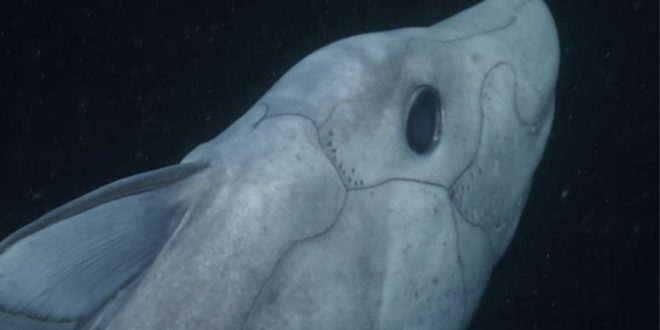Scientists have captured the first-ever footage of an extremely rare fish known as a ghost shark, a recent study in the journal Marine Biodiversity Records reports.
It’s a species that split off from sharks and rays around 300 million years ago, existing as a chimera, or blend of the two. The ghost shark, as the video explains, doesn’t even have the shark teeth of its more recognizable shark relatives. Instead, it has tooth plates, which it uses to munch on small critters in the darkest parts of the oceans.
As study author Lonny Lundsten and colleagues reported earlier this year in the journal Marine Biodiversity Records, they saw the ghost shark swimming at depths of 1,640 meters (about 5,381 feet) in the central and eastern North Pacific Ocean, extending the creature’s known geographic range by approximately 6,000 kilometers (more than 3,700 miles).
In a statement, the MBARI team said that this marked the first time that Hydrolagus trolli had been officially identified anywhere in the Northern Hemisphere. The video footage was captured by a remotely operated vehicle (ROV) during one of several dives off the coast of California and the Hawaiian islands, according to Washington Post reports published over the weekend.
First identified in 2002, the pointy-nosed blue ratfish (also known as a chimera) has a skeleton made of cartilage instead of bone and gets its name from its jaw, which is fused to its skull and gives its face an appearance similar to that of a rodent. The creature also has a retractable penis on its forehead, but scientists are not entirely certain how this unusual organ is used.
In their recently-published study, Lundsten’s team presented evidence suggesting that the ghost sharks spotted by their ROV were the same that had been previously identified as living only in the Southwestern Pacific. However, while they believe the physical characteristics of both types of creatures are similar, they cannot definitely confirm this without actually collecting one of the fish featured in the video and bringing it back to the surface for additional analysis.
“This is much easier said than done, because these fish are generally too large, fast, and agile to be caught by MBARI’s ROVs,” the Institute explained. “If and when the researchers can get their hands on one of these fish, they will be able to make detailed measurements of its fins and other body parts and perform DNA analysis on its tissue,” thus either confirming that it is part of the same species, or allowing them to assign it to a new species altogether, they added.
“If these animals turn out to be the same species as the ghost sharks recently identified off California,” MBARI officials concluded, “it will be further evidence that, like many deep-sea animals, the pointy-nosed blue chimera can really get around.”
Agencies/Canadajournal
 Canada Journal – News of the World Articles and videos to bring you the biggest Canadian news stories from across the country every day
Canada Journal – News of the World Articles and videos to bring you the biggest Canadian news stories from across the country every day




Just from the picture: the eye is black – like your pupil – therefore highly light-sensitive, and it seems to have a lens [refraction on the angle of the photo] thee fore it must see in some way [infra-red or ultraviolet maybe?].
Eyes also have the ability to sense pressure [like your ears as air pressure causes them to pop when you fly]. In any case I would suspect that it has developed the ability to sense using other methods, like a sort of passive radar [rather than active echo-sonar location like dolphins, whales or bats].